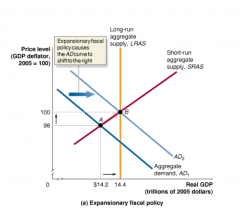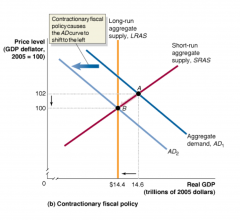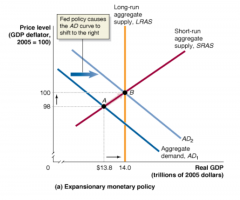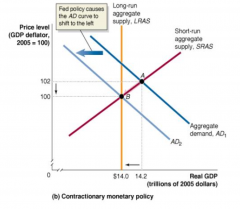![]()
![]()
![]()
Use LEFT and RIGHT arrow keys to navigate between flashcards;
Use UP and DOWN arrow keys to flip the card;
H to show hint;
A reads text to speech;
51 Cards in this Set
- Front
- Back
|
fiscal policy
|
CONGRESS & PRESIDENT
changes in FED TAXES & PURCHASES affects NATIONAL ECONOMY thru AGGREGATE DEMAND by changing PRICE LEVEL & REAL GDP |
|
|
govt. purchases
|
spending by fed. govt. on goods & services (salaries of fed. govt. agencies, purchase of aircraft carriers)
RESULT IN PROD. OF NEW GOODS & SERVICES NO TRANSFER PAYMENTS |
|
|
govt. expenditures
|
fed. govt. purchases + all other govt. spending
(1) interest on national debt (payments to holders of the bonds the fed. govt. has issued to borrow $ (2) grants to state & local govts. (payments made by fed. to support govt. activity @ state & local levels) (3) TRANSFER PAYMENTS (Social Security, Medicare, unemployment insurance, programs to aid poor) - largest & fastest-growing category |
|
|
automatic stabilizer
|
govt. spending & taxes that automatically increase/decrease along w/ business cycle
happens w/o govt. action expansion - employment & incomes increasing, govt. spending on unemployment insurance payments decrease & govt. collection of taxes increase b/c ppl. are paying higher taxes on higher incomes opp. for recession |
|
|
discretionary fiscal policy
|
govt. takes actions to change spending/taxes
|
|
|
expansionary fiscal policy
|

increasing govt. purchases/decreasing taxes
increases AD actual GDP < potential GDP real GDP & price level rise |
|
|
contractionary fiscal policy
|

decreasing govt. purchases/increasing taxes
reduces AD actual GDP > potential GDP real GDP & price level fall |
|
|
timing
|
potential fiscal policy problem
delays caused by legislative process can be very long even after a change has been approved, it takes time to implement |
|
|
crowding out
|
potential fiscal policy problem
decline in private expenditures as result of increase in govt. purchases |
|
|
fed. govt. budget
|
relationship btwn. EXPENDITURES & TAX REVENUE
|
|
|
budget deficit
|
govt. expenditures > tax revenue
increases during wars & recessions (b/c of automatic stabilizers: wages & profits fall -> tax revenues fall, govt. increases spending on TR; discretionary fiscal policy: increasing spending/cutting taxes to increase AD; usually takes place w/o Congress or president taking action) |
|
|
budget surplus
|
govt. expenditures < tax revenue
|
|
|
fed. govt. debt.
|
total value of US Treasury bonds outstanding
deficit: Treasury must borrow funds from investors by selling Treasury securities, debt grows surplus: Treasury pays off existing bonds, debt shrinks |
|
|
Fed. Reserve
|
in charge of managing $ SUPPLY & INTEREST RATES (2 monetary policy targets)
|
|
|
expansionary monetary policy
|

FOMC orders expansionary policy -> $ supply increases & interest rates fall -> I, C, & NX increase -> AD shifts right -> real GDP & price level rise
|
|
|
contractionary fiscal policy
|

FOMC orders contractionary policy -> $ supply decreases & interest rates rise -> I, C, & NX decrease -> AD shifts left -> real GDP & price level fall
|
|
|
real GDP
|
value of final goods & services evaluated @ base-yr. prices
hold prices constant (PURCHASING POWER of dollar remains same from 1 yr. to next) which makes it a better measure than nominal GDP greater than nominal in yrs. before base yr. & less for yrs. after base yr. & equal in base yr. drawback - over time prices may change |
|
|
nominal GDP
|
value of final goods & services evaluated @ current yr. prices
|
|
|
GDP
|
included: domestically prod. final goods & services (including capital goods), new construction of structures, changes to inventories (GDP = final sales + changes to inventories)
not included: intermediates goods & services, inputs, used goods, financial assets likes stocks & bonds, TR, foreign-prod. goods & services |
|
|
frictional unemployment
|
short-term that arises from process of matching workers w/ jobs
low unemployment rate, periods of unemployment are shorter, suggesting most of unemployment is frictional opp. during high unemployment rate |
|
|
structural unemployment
|
arises from persistent mismatch btwn. skills & attributes of workers & requirement of jobs
last longer periods b/c workers need time to learn new skills |
|
|
cyclical unemployment
|
caused by a business cycle recession
|
|
|
natural rate of unemployment
|
full-employment rate of unemployment
normal rate of unemployment frictional + structural |
|
|
labor force
|
sum of unemployed & employed workers in economy
BLS CLASSIFIES PPL. WHO DON'T HAVE A JOB & WHO AREN'T ACTIVELY LOOKING FOR A JOB AS NOT IN THE LABOR FORCE |
|
|
GDP deflator
|
measure of price level
calculated by dividing nominal GDP by real GDP x 100 measure of avg. level of prices of FINAL GOODS & SERVICES in economy BROADEST MEASURE OF PRICE LEVEL & may not clearly indicate how inflation affects typical household |
|
|
Consumer Price Index (CPI)
|
avg. of prices of goods & services purchased by typical urban family of 4
COST-OF-LIVING INDEX |
|
|
Producer Price Index (PPI)
|
avg. of prices received by prods. of good & services @ all stages of prod. process
measure prices of raw materials, intermediate goods, or final goods used by prods. instead of consumers |
|
|
consumption
|
increases when: current disposable income, household wealth, & expected future income increases
decreases when: price level and interest rate increases |
|
|
investment
|
increases when: expectations of future profitability & profits (cash flow) increases
decreases when: interest rate & taxes increase |
|
|
net exports
|
increases when: price level in US relatively lower than other countries
decreases when: growth rate of US GDP relatively higher than other countries & when the exchange rate btwn. dollar & other currencies is more valuable in US currency |
|
|
movement along AD curve
|
CHANGES IN PRICE LEVEL only affects QUANTITY OF GOODS & SERVICES DEMANDED in economy, NOT DEMAND FOR GOODS & SERVICES
|
|
|
shift AD curve left
|
increase in INTEREST RATES (MONETARY POLICY, raise cost to firms & households of borrowing, reducing C & I)
decrease in DISPOSABLE INCOME (INCOME + TR - T) decrease in EXPECTED PROFITS FROM FIRMS decrease in EXPECTED FUTURE INCOME increase in PERSONAL TAXES (FISCAL POLICY, C falls when T rises) increase in BUSINESS TAXES (FISCAL POLICY, I falls when T rises) increase in VALUE OF DOMESTIC CURRENCY RELATIVE TO FOREIGN CURRENCIES (M rise, X fall -> reducing NX) decrease in GOVT. PURCHASES increase in growth rate of domestic GDP relative to foreign GDP (M increase > X -> reduces NX) |
|
|
shift AD curve right
|
increase in govt. purchases (FISCAL POLICY)
increase in households' expectations of their future incomes (C increases) increase in firms' expectations of future profitability from I (I increases) |
|
|
shift SRAS curve right
|
DOESN'T SHIFT B/C OF FISCAL OR MONETARY POLICY
increase in labor force/capital stock (SHIFTS LRAS RIGHT; more output can be prod. @ every price level) increase in productivity (SHIFTS LRAS LEFT, costs of prod. output fall) |
|
|
shift SRAS curve left
|
increase in future price level (workers & firms increase wages & prices)
increase in workers & firms adjusting to having previously under-estimated the price level (workers & firms increase wages & prices) increase in expected price of important natural resource (cost of prod. output rise) |
|
|
key assets on bank's balance sheet
|
reserves
loans holdings of securities (US Treasury bills) |
|
|
assets
|
value of anything owned by firm
|
|
|
liabilities
|
value of anything firm owes
s |
|
|
stockholders' equity
|
diff. btwn. total value of assets & total value of liabilities
represents value of firm if it had to be closed, all its assets were sold, & all its liabilities were paid off CORP.'S STOCKHOLDERS' EQUITY REFERRED TO AS ITS NET WORTH |
|
|
reserves
|
deposits a bank keeps as cash in vault/on deposit w/ Fed. Reserve
NOT LOANED OUT OR INVESTED not part of currency circulation |
|
|
required reserves
|
reserves a bank is legally required to hold, based on checking account deposits
banks are required by law to keep as reserves 10% of checking account deposits |
|
|
required reserve ratio
|
min. fraction of deposit banks are required by law to keep as reserves
|
|
|
excess reserves
|
reserves that banks hold over & above legal requirement
to guard against possibility that many depositors may simultaneously make w/drawls from their accounts |
|
|
consumer loans
|
households
|
|
|
commercial loans
|
businesses
|
|
|
deposits
|
banks' largest liability
checking accounts, savings accounts, & certificates of deposit |
|
|
monetary policy tools
|
that Fed. uses to manage $ supply
open market operations discount policy reserve requirements |
|
|
open market operations
|
buying & selling of Treasury securities by Fed. Reserve to control money supply
|
|
|
FOMC
|
TO INCREASE $ SUPPLY: directs TRADING DESK located @ Fed. Reserve Bank in NY, to BUY US Treasury securities from public; when the sellers deposit the funds into their banks, reserves rise -> starts process of increasing loans & checking account deposits -> increases $ supply
TO DECREASE $ SUPPLY: directs trading desk to SELL Treasury securities; when buyers pay for them w/ checks, reserves fall -> starts contraction of loans & checking account deposits -> reduces $ supply |
|
|
discount policy
|
discount rate: rate @ which Fed. loans out $ to banks as lender of last resort
rate increased - more expensive for banks to borrow in order to meet required reserve amounts -> causes banks to be more careful about reserves, keep more reserves, & make fewer loans -> decreases checking account deposits & $ supply when banks borrow from Fed., banks' reserves increase |
|
|
reserve requirements
|
when Fed. reduces required reserve ratio, it converts required reserves into excess reserves
|

